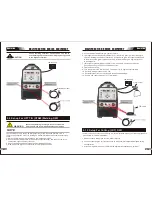
133
132
133
132
Match regulator to cylinder. NEVER CONNECT a regulator designed for
a particular gas or gases to a cylinder containing any other gas.
The regulator/ ow meters used with argon based and carbon dioxide shielding gases are
different. A suit able regulator/ ow meter will need to be fitted.
All valves downstream of the regulator must be opened to obtain a true ow rate reading on
the outlet gauge. (Welding power source must be triggered) Close the valves after the pressure
has been set.
Installation
1. Remove cylinder valve plastic dust seal. Clean the cylinder valve outlet of impurities that
may clog orifices and damage seats before connecting the regulator. Crack the valve
(open then close) momentarily, pointing the outlet away from people and sources of ignition.
Wipe with a clean lint free cloth.
2. Match regulator to cylinder. Before connecting, check that the regulator label and cylinder
marking agree and that the regulator inlet and cylinder outlet match. NEVER CONNECT
a regulator designed for a particular gas or gases to a cylinder containing any other gas.
3. Connect the regulator inlet connection to cylinder or pipeline and Tighten it firmly but
not excessively, with a suitable spanner.
4. Attach supplied gas line between the regulator output and the desired input at the rear
of the power source.
CAUTION
Ensure that the gas cylinder is
secured to a building pillar, wall
bracket or otherwise securely
fixed in an upright position.
NOTE
NOTE
Operation
Operation
power supply
MIG
SERIES
EQUIPMENT
MIG SERIES
EQUIPMENT
5. To protect sensitive down-stream equipment a separate safety device may be necessary
if the regulator is not fitted with a pressure relief device.
Operation
With the regulator connected to cylinder or pipeline, and the adjustment screw/knob fully
disengaged, pressurize as follows:
1. Stand to one side of regulator and slowly open the cylinder valve. If opened quickly, a
sudden pressure surge may damage internal regulator parts.
2. With valves on downstream equipment closed, adjust regulator to approximate working
pressure. It is recommended that testing for leaks at the regulator connection points be
carried out using a suitable leak detection solution or soapy water.
3. Purge air or other unwanted welding grade shielding gas from equipment connected to
the regulator by individually opening then closing the equipment control valves. Complete
purging may take up to ten seconds or more, depending upon the length and size of the
hose being purged.
Adjusting Flow Rate
With the regulator ready for operation, adjust working ow rate as follows:
1. Slowly turn adjusting screw/knob in (clockwise) direction until the outlet gauge indicates
the required ow rate.
It may be necessary to re-check the shielding gas regulator ow rate following the first weld
sequence due to back pressure present within shielding gas hose assembly.
2. To reduce ow rate, allow the welding grade shielding gas to discharge from regulator by
opening the down- stream valve. Bleed welding grade shielding gas into a well ventilated
area and away from any ignition source. Turn adjusting screw counterclockwise, until the
required ow rate is indicated on the gauge. Close downstream valve.
3. Adjust regulator pressure adjusting screw to the required ow rate, indicated on gauge dial.
The gas ow rate should be adequate to cover the weld zone to stop weld porosity. Excessive
gas ow rates may cause turbulence and weld porosity.
NOTE
Screw knob











































